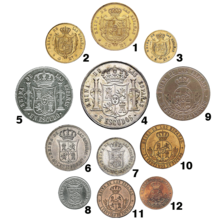Spanish escudo
The Spanish escudo consisted of two different types of coin, on the one hand the gold standard coin until 1833, on the other hand a decimal silver coin that was minted from 1864-68.
Under Charles I.
The Spanish King Carlos I from 1516, as Charles V , was ruler of the Habsburg hereditary lands and German emperor from 1506 . He was particularly heavily indebted to the Fuggers . The Ducado had continued to deteriorate. In 1537 a currency reform was necessary. Instead of the Ducados, which was no longer pronounced but remained as a unit of account, coronas i escudos were to be minted in gold . For the Castilian gold mark of 22 carats (i.e. 11/12 fine) there were 68 escudos, each worth 350 maravedís . With the same weight of the coins, the fineness was reduced by 7½%.
Under Philip II
The value of the escudo was raised to 400 maravedís by decree ( Pragmatica ) of Philip II on November 23, 1566. Larger pieces were now also minted. The double escudo ( doblón ) was called the pistol in Europe and was the model for the Louis d'or . The 8 escudo piece ( onza de oro ) became the most common Spanish gold coin and is known as the doubloon (= 4 pistols). It corresponded to 16 silver peso duro (51.122 g of fine silver), ie two "pieces of eight", which over time, especially after the introduction of machine minting in 1732, became the dominant trade coin in East Asia.
| Ref. | designation | metal | Ley (ml) | Peso (g) | Ø (mm) | Coin edge | Displayed | Mint |
|---|---|---|---|---|---|---|---|---|
| 1 | 10 escudos | Oro |
|
|
|
|
1865 y 1868 | M S |
| 2 | 4 escudos | Oro |
|
|
|
|
1865 y 1868 | M S |
| 3 | 2 escudos | Oro |
|
|
|
|
1865 y 1868 | M. |
| 4th | Plata |
|
|
|
|
1864 y 1868 | M. | |
| 5 | 1 escudo | Plata |
|
|
|
|
1864 y 1868 | M. |
| 6th | 40 céntimos | Plata |
|
|
|
|
1864 y 1868 | B M S |
| 7th | 20 céntimos | Plata |
|
|
|
|
1865 y 1868 | M S |
| 8th | 10 céntimos | Plata |
|
|
|
|
1865 y 1868 | M S |
| 9 | 5 céntimos | Cobre |
|
|
|
|
1865 y 1868 | B M J Sg S |
| 10 | 2½ céntimos | Cobre |
|
|
|
|
1865 y 1868 | B M J Sg S |
| 11 | 1 céntimo | Cobre |
|
|
|
|
1864 y 1868 | B M J Sg S |
| 12 | ½ céntimo | Cobre |
|
|
|
|
1864 y 1868 | B M J Sg S |
| B = Barcelona M = Madrid J = Jubia Sg = Segovia S = Sevilla | ||||||||
18th century
According to the reform laws of 1728 and 1730, which stipulated, among other things, coins that could not be blended , the fineness of the onza de oro remained at 22 carats.
From 1772 there was a deterioration to 901/1000. On June 25, 1786, a secret instruction was issued that the escudo was only to be minted from 21-carat gold (875/1000); in fact, even worse metal was used: tests show an average of 869.8 / 1000, after 1800 only 864 , 6/1000.
| Equivalents | |
|---|---|
|
|
|
| 8 escudos | 320 real |
| 4 escudos | 160 real |
| 2 escudos | 80 real |
| 8 real | 20 real |
| 4 real ones | 10 real |
| 2 real | 5 real |
| 1 real | 2½ real |
| 1/2 real | 1¼ real |
| 8 maravedíes | |
| 4 maravedíes | |
| 2 maravedíes | |
| 1 maravedí | |
1850 to 1868
The decimal real (de vellón) became the Spanish standard currency in 1850, and the Catalan peseta was converted to a ratio of 1 pta. = 4 reals exchanged. The next currency change took place in 1864 when the new decimal escudo was introduced. 1 escudo = 10 reales = 100 centimos = 1000 millesimas.
As early as 1868, after the first abolition of the monarchy, the Spanish peseta was introduced , with a ratio of 2½ pts. per Escudo. Escudos circulated until 1872.
See also
Individual evidence
- ↑ Henry Charles Lea: History of the Spanish Inquisition. First volume. European History Publishing House 2012, ISBN 3-8638-2735-X . P. 570

